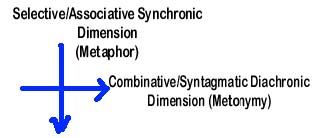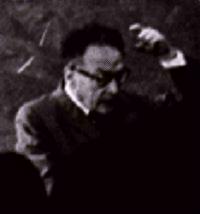|
Starting Questions:
-
What are the basic functions of language in communication?
What is the poetic function?
-
Is there a common semantic operation in sentence-making and the
making of poems, films, and the other cultural languages?
I. General Introduction
1) The difference between the Prague School and de Saussure:
"Whereas Saussure had insisted that the study of the
structural relations within and between languages as they exist at any
given time (synchonistic study) and the study of the changes in sounds
and their relations over time (diachronic study) were completely
separate and mutually exclusive, the Prague School said: 'It is the structural analysis of language in the
process of development -- the analysis of children's language and
its general laws -- and of language in the process of
disintegration -- aphasic language -- which enables us to throw light
on the selection of phonemes, the distinctive features, and their
mutual relations, and to get closer to the main principles of this
selection and of this interdependence so as to be in a position to
establish and explain the universal laws which underlie the
phonological structure of the world's languages.' [external
link: Lectures
on Sound and Meaning, 1942] (underline added; source: as above)
2) His Communication
theory:
"... the addresser
sends a message to the addressee.
To be operative, the message requires a context
referred to, seizable by the addressee, and either verbal or capable
of being verbalized; a code
fully, or at least partially, common to the addresser and the
addressee; and finally, a contact,
a physical channel and psychological connection between the addresser
and the addressee, enabling both of them to enter and stay in
communication. (Norton Anthology 1260)"
criticism: Human commmunication is never one-way. Communication is inter-subjective. (Walter Ong
and other views of communication as dialogue)
3) His view of
literature: "Linguistics and Poetics" --
The poetic is one of
the six functions of language; the other five are:
referential (context), emotive (speaker), conative (addressee), phatic
(channel of communication), metalinguistic (explanation
of the code).
The poetic function vs. poetry: "The poetic
function is not the sole function of verbal art but only its dominant,
determining function, whereas in all other verbal activities it acts
as a subsidiary, accessory constituent. This function, by
promoting the palpability of signs, deepens the fundamental dichotomy
of signs and objects. (Norton 1264)
e.g. "I like Ike"
"The
poetic function projects the principle of equivalence
from the asix of selection into the axis of combination.
Equivalence is promoted to the constitutive device of the
sequence." (Norton 1265)
II. "The Metaphoric and
Mytonymic Poles" Main idea: The metaphoric and
mytonymic are two aspects of language that are at work in our
daily language (as is evidenced in aphasic disorders) as well as
literature, dream, arts and folklore.
Method: His major argument is derived from clinical observation, and
then he makes several analogy between daily language and poetic
language, and then film, paintings and other cultural
languages. 
Similarity
disorder
– inability to deal with “associative”
relationships in language. Contiguity
disorder –inability to organize words into higher units (e.g.
sentence) e.g.
1) children's responses to a well-known psychological test--to respond
to the noun shown to them.
two types of responses: predicative ("the hut was burned out; the
hut is a poor little house") and substitutive (cabin, hovel, etc.)
--> two kinds of connection (similarity and contiguity) in both
their aspects (positional and semantic) --selecting, combining and
ranking them. e.g.
2) verbal art : The
metaphoric constructions dominate --Russain lyrical songs; Romanticism
and Symbolism; D. W. Greiffith in films. The
metonymic -- Realist author, metonymically digresses from the plot to
the atmosphere and from the characters to the setting. . .(1267);
Einenstein and Chaplin in films; |

